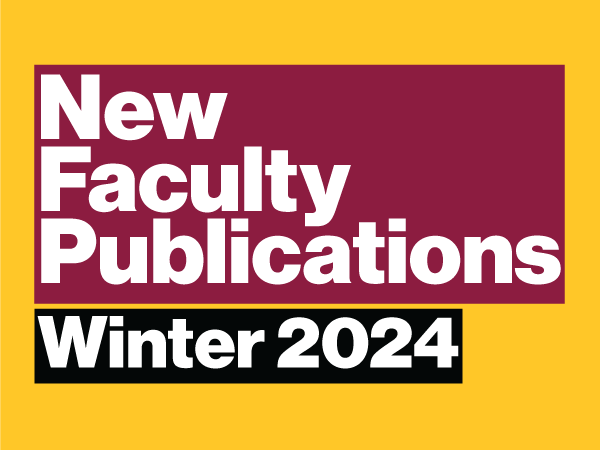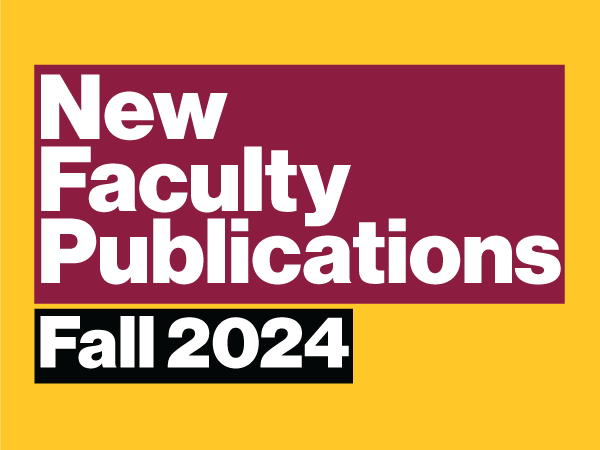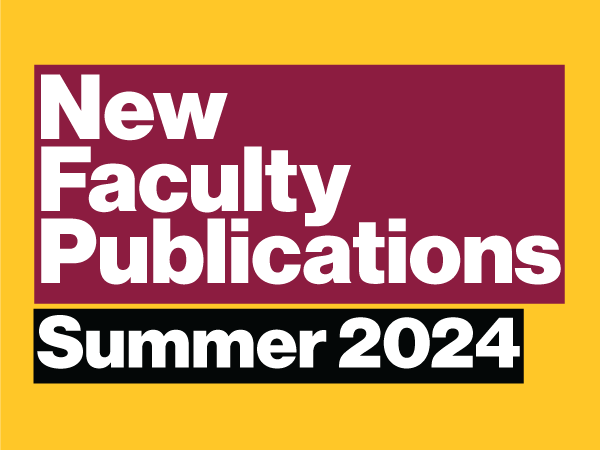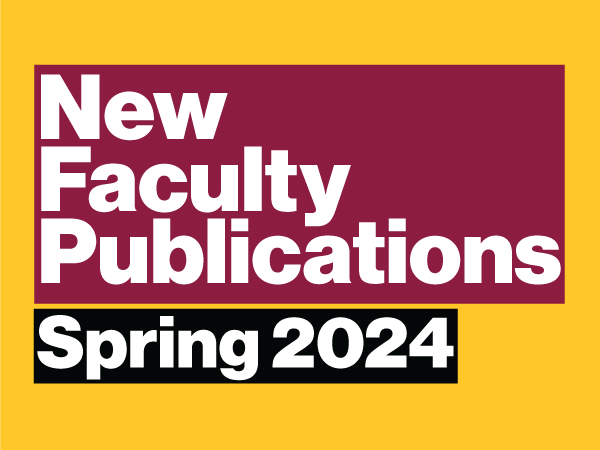This bibliography comprises scholarly books, book chapters, and journal articles published or accepted for publication by full-time, emeritus, and retired faculty of the Sandra Day O’Connor College of Law between October 1, 2023 and December 31, 2023.
Jessica Berch & Daniel J. Capra, It’s a Code: Amending the Federal Rules of Evidence to Achieve Uniform Results, 58 Wake Forest Law Review 549 (2023)
This Article identifies, explores, and attempts to resolve nine conflicts that have arisen in the federal courts regarding the proper interpretation and scope of the Federal Rules of Evidence. For each conflict, we set forth the language of the current rule, its policy goals, and the differing positions taken by the courts. We then analyze the merits of the debate and propose new rule language to resolve the matter.
In this Article, we consider whether theft-based convictions are automatically admissible under Rule 609(a)(2), and how to calculate the passage of ten years for old convictions under Rule 609(b). We chart the hazy line between lay and expert opinion testimony under Rules 701 and 702 to determine whether, for example, a law enforcement officer’s opinion about things like code words qualifies as expert or lay opinion. We discuss two debates arising from Rule 801(d)(2): first, whether an expert’s statements are attributable to the party that retained the expert, and second, whether statements by government officials are statements by a government party, particularly in criminal cases. We tackle whether Rule 803(3) permits statements about a declarant’s state of mind to prove another person’s actions, and the foundation necessary under Rule 803(4) to admit statements by children regarding child abuse. We end the Article by analyzing the meaning of “predecessor in interest” for purposes of Rule 804(b)(1), and also whether exculpatory grand jury testimony is admissible against the government under that same rule.
Dan Bodansky, International Legal Theory: Foundations and Frontiers, 117 American Journal of International Law 735 (2023)
What is international legal theory and what is it good for? These are the questions that Jeffrey Dunoff and Mark Pollack’s latest edited collection seeks to address. Dunoff, an international lawyer, and Pollack, an international relations scholar, have had many fruitful collaborations, including a co-edited volume on the relationship between international law and international relations theory. Their new book aims to provide a broad overview of international legal theory, and includes chapters on both staples of the field, such as positivism, natural law, legal realism, transnational legal process, critical international legal theory (CILT), Third World Approaches to International Law (TWAIL), feminist theories, and rational choice, as well as more recent approaches, such as global administrative law (GAL), constitutionalism, global legal pluralism, behavioralism, sociological approaches, and the practice of interpretation.
Andrew Carter, The Exclusionary Rule is Dead. Long Live the Exclusionary Rule., 30 Virginia Journal of Policy & the Law 116 (2023)
My legal training was the liberal kind, and I started this paper with a vague goal of mounting a spirited defense of the Fourth Amendment exclusionary rule against the incursions of the modern Supreme Court. But the rule I set out to defend—where ill-gotten evidence is excluded irrespective of the underlying crime or the nature of the officer’s misconduct—is dead, and it has been for a while. Frankly, it was doomed from the start. Trial court judges are, under their judicial robes, human beings. Their decision-making was always going to express a “moral” exclusionary rule: one where exclusion of ill-gotten evidence is reserved for unignorable police misconduct and prosecutions of misdemeanors and vice crimes. It is time to accommodate this reality. It is time to adopt an exclusionary rule for the real world.
Adam Chodorow et al., Common Sense Recommendations for the Application of Tax Law to Digital Assets (October 16, 2023) (Wayne State University Law School Research Paper No. 2023-22)
In response to the Joint Committee on Taxation’s July 2023 request for comments on application of various Internal Revenue Code sections on digital assets, we propose a consistent set of rules to apply current law to digital assets. We highlight that the underlying economics and characteristics of transactions should be the primary concern for the application of rules and the valuation of digital assets. We believe any digital asset rules should (1) treat classes of digital assets with unique characteristics differently based on their economics, (2) minimize incentives for users to engage in tax-motivated structuring of transactions, and (3) allow the Internal Revenue Service authority to react to and regulate new classes of digital assets as they are created. We do not believe that the unique features of digital assets are a challenge to applying current law or warrant special tax preferred treatment.
Joel Friedman, The Law of Employment Discrimination: Cases and Materials (14th ed., Foundation Press 2023)
This casebook covers all major aspects of employment discrimination law, including benchmark legislative, administrative, and judicial developments. Due in part to frequent updates and revisions, it has received accolades as one of the most comprehensive and frequently updated texts on the market. The 14th Edition continues this tradition by seamlessly incorporating all major legislative and judicial developments through July 2023, including all relevant decisions rendered by the Supreme Court in its 2022-2023 term. The major Supreme Court rulings were in Groff v. DeJoy and Students for Fair Admissions, Inc. v. President and Fellows of Harvard College. In Groff, a unanimous Court expanded an employer’s duty to accommodate religious beliefs and practices under Title VII by ruling that the standard of undue hardship requires a showing that the burden is substantial in the overall context of an employer’s business, including an assessment of the impact on the coworkers. Instead of having to prove only the incurring of a de minimis expense, an employer now must show the burden is excessive or unjustifiable. In Students for Fair Admissions, a non-employment case, a six-member majority ruled that the use of race in the admissions policies of the two defendants (Harvard and the University of North Carolina) violated the Equal Protection Clause of the Fourth Amendment. Applying strict scrutiny to the defendant’s acknowledged use of race in their admissions processes, the Court ruled that these programs failed both the compelling interest and narrowly tailored components of strict scrutiny.
Joel Friedman, Examples & Explanations: Employment Discrimination (5th ed., Aspen 2023)
Comprehensive and easily understood, the Fifth Edition of Examples & Explanations: Employment Discrimination offers students a precise synopsis of employment discrimination law along with numerous deftly written questions to help students accurately and persuasively apply the applicable doctrine to the relevant facts.
Jamie Grischkan, Banking and the Antimonopoly Tradition: The Long Road to the Bank Holding Company Act in Antimonopoly and American Democracy (Daniel A. Crane & William J. Novak eds., Oxford University Press 2023)
“Banking and the Antimonopoly Tradition: The Long Road to the Bank Holding Company Act” excavates the history of the bank holding company, a corporation that owns or controls one or more US banks, and the movement to prevent its monopolistic expansion in the decades surrounding World War II. Staked on constitutional grounds that emphasized the dangers of concentrated financial power to democratic governance, the battle for bank holding company reform represents a pivotal, yet virtually unacknowledged, chapter of the American antimonopoly tradition. Culminating in the enactment of the Bank Holding Company Act in 1956, the struggle for bank holding company legislation challenges long-standing narratives of American political economy that portray World War II as the end of Progressive economic reform and the antitrust movement as a faded passion. Foregrounding the neglected history of the rise and regulation of bank holding companies in the twentieth century ultimately reveals that antimonopoly ideals survived long after their supposed demise and continued to structure national policymaking well into the postwar decades.
Jamie Grischkan, Regulating Bank Mergers: Past and Present, 2024 University of Illinois Law Review (forthcoming 2024)
For the first time in nearly half a century, bank merger policy stands at a crossroads. Amidst a new and wide-ranging antimonopoly movement, concerns regarding concentrated financial power and the structure of the American banking system have taken center stage. Following calls for public comment on revising the 1995 Bank Merger Competitive Review Guidelines by the Department of Justice, internal discord over reform efforts at the FDIC, and the failure of numerous regional banks, a fundamental reassessment of the law governing bank mergers and acquisitions is firmly underway. While some policymakers and scholars have argued that antitrust law should play a larger role in preventing consolidation in the financial sector, this Article employs the methodology of legal history to emphasize the limits of reviving antitrust in banking.
Excavating the origins and evolution of the Bank Holding Company Act (the “BHCA”) and the Bank Merger Act (the “BMA”), which govern regulatory oversight of bank mergers, reveals that an expansive conception of the public interest extending well beyond the bounds of antitrust doctrine guided the bank merger regime in its formative early years. By retracing the legislative, administrative, and judicial interpretations of the public interest approach to bank mergers, this Article foregrounds an alternative, and historically potent, mechanism through which to combat banking consolidation. Ultimately, the complex history of the BHCA and BMA provides an important reminder that while antitrust has long served as a critical weapon in the battle against concentrated economic power, it has not been the only weapon. As the future of bank merger policy hangs in the balance, a turn to the past may therefore yield a more promising way forward.
Zach Gubler, The Neoclassical View of Corporate Fiduciary Duty Law, 91 University of Chicago Law Review 165 (2024)
Traditionally, corporate fiduciary duties are said to run to the corporation itself. But what does this mean? Something, this Article argues, that is quite different from what both shareholder and stakeholder value maximization proponents think. Specifically, the argument is that corporate fiduciary duties are owed not to any flesh and blood stakeholder, including current shareholders, but rather to a hypothetical permanent investor whose holding period is forever. Like any statement of corporate purpose, this “permanent equity maximization norm” is rooted in an underlying model of the corporation. In this case, the underlying model must be one that sees the corporation as a vehicle uniquely designed for long-term capital allocation and therefore emphasizes the corporation’s perpetual existence as the most important attribute for understanding the nature of a corporation.
This interpretation of corporate fiduciary duties — what this Article calls the “neoclassical view” — does a better job than alternatives in explaining various puzzling features of corporate law, including the apparently conflicting focus on shareholder value maximization on the one hand and the reluctance, on the other, to hold corporate fiduciaries who engage in insider trading liable for common law fraud. It also explains the allocation of decision rights in the corporation, including why decision-making power is located in the board but also why shareholders have the right to bring derivative lawsuits and vote on certain matters. Under this view, the shareholder franchise is less about giving voice to shareholders and more about providing a tool the board can use at its choosing to generate information to help it in the difficult task of long-term capital allocation.
Perhaps the most important implication stemming from this neoclassical view of corporate fiduciary duty law is that, although a corporation deals in contracts, the corporation itself is not a creature of contract, and corporate law is not necessarily contractarian as a fundamental matter. Rather, the corporation represents a policy decision to create an entity designed for extreme long-term capital allocation without sacrificing a liquid securities market. More generally, this analysis demonstrates that the concern over “short-termism” in the corporation is not simply a passing fancy but rather is deeply embedded in fiduciary duty law and lies at the core of what a corporation is.
James G. Hodge, Jr. & Leila Barraza et al., Supreme Court Impacts in Public Health Law: 2022-2023, 51 Journal of Law, Medicine & Ethics 684 (2023)
In another tumultuous term of the United States Supreme Court in 2022-2023 a series of critical cases implicate instant and forthcoming changes in multiple fronts that collectively shift the national public health law and policy environment. As examined in this article across 10 core public health law themes, SCOTUS (1) upended affirmative action policies, (2) skirted past social media liability for misinformation, (3) reduced criminal liability for cyberthreats, (4) opened health care and public health agencies to newfound claims, (5) injected itself into medication abortion debates, (6) denied executive authority to forgive federal student loan debts, (7) re-defined the breadth of First Amendment religious freedoms, (8) assessed discriminatory impacts of racial redistricting, (9) rejected federal obligations to assure water rights for tribal nations, and (10) avoided resolving immigration policies tied to public health emergency powers. For a Court persistently mired in controversy and disapproval among Americans, this term breaks new ground yet again in the ever-changing public health legal landscape.
James G. Hodge, Jr. & Erica N. White et al., Medicare Drug Pricing Negotiations: Assessing Constitutional Structural Limits, Journal of Law, Medicine & Ethics (forthcoming)
A series of structural constitutional arguments lodged in multiple cases against Centers for Medicare and Medicaid Services’ (CMS) authorities to negotiate prescription drug prices via the 2022 Inflation Reduction Act threaten the legitimacy of CMS program and federal agency powers.
James G. Hodge, Jr. & Jennifer L. Piatt et al., COVID vaccines went ‘on trial.’ Are routine childhood vaccine mandates at risk?, Bulletin of the Atomic Scientists (November 24, 2023)
Vaccines, one of the greatest public health achievements of the 20th century, proved their worth, yet again, in response to one of the greatest infectious disease threats of all time: COVID-19. Approximately 70 percent of Americans completed the original primary series of COVID vaccines, helping to restart the global economy and allow people to escape social isolation. These vaccines prevented an estimated 3.2 million deaths nationally between December 2020 and November 2022. Millions more were spared the risks of extensive hospital stays, extended illness from “long-COVID,” and other substantial harms. Earlier this year, researchers contributing to the science underlying the vaccines were awarded a Nobel Prize.
Despite this positive track record, significant skepticism remains about COVID and other vaccines. Scores of Americans refused to get vaccinated during the pandemic despite strong incentives and clear dangers to their and their families’ health, a trend that has intensified in recent years. Just 17 percent of Americans received the critical omicron booster shot offered in late 2022. Considerably fewer (7.1 percent of adults and 2.1 percent of children as of October 14) have sought the updated COVID vaccines that became available this fall. One of the most contentious pandemic-era debates—fueled by apathy, safety concerns, misinformation, and government distrust—involves the use of vaccine mandates by governments, schools, and employers to boost COVID vaccination rates.
Although the United States has a long-standing and legally supported history of vaccination requirements in certain contexts, the COVID pandemic witnessed scores of lawsuits challenging them, as political and media figures vilified vaccination and other public health measures. These lawsuits touched on constitutional issues and statutory concerns, with plaintiffs seeking exemptions or an end to mandate enforcement altogether. And while several states have moved to further restrict or eliminate vaccine mandates, the Supreme Court has opened the door to increased challenges under the Civil Rights Act, which may heighten exemptions that could undermine the efficacy of vaccine efforts. COVID’s tidal wave of lawsuits, state legislation, and vaccine skepticism evince an environment where vaccines are truly “on trial.”
Robert J. Miller & Harry Hobbs, Unraveling the International Law of Colonialism: Lessons from Australia and the United States, 28 Michigan Journal of Race & Law 271 (2023)
In the 1823 decision of Johnson v. M’Intosh, Chief Justice John Marshall formulated the international law of colonialism. Known as the Doctrine of Discovery, Marshall’s opinion drew on the practices of European nations during the Age of Exploration to legitimize European acquisition of territory owned and occupied by Indigenous peoples. Two centuries later, Johnson – and the international law of colonialism – remains good law throughout the world. In this Article we examine how the Doctrine of Discovery was adapted and applied in Australia and the United States. As Indigenous peoples continue to press for a re-examination of their relationships with governments, we also consider whether and how the international law of colonialism has been mitigated or unraveled in these two countries. While we find that the Doctrine lingers, close examination provides several important lessons for all Indigenous nations and governments burdened by colonization.
Troy A. Rule, Does DARC Really Matter?: A Response to Wright & Moore, 109 Iowa Law Review Online 1 (2023)
Danaya Wright and Ethan Moore’s Article, DARC Matters: Repurposing Nineteenth-Century Property Law for the Twenty-First Century, is a valuable contribution to a growing body of legal academic literature focused on property law obstacles to the deployment of commercial drone technologies. Wright and Moore rightly acknowledge landowners’ long-held rights to exclude objects from the low airspace immediately above their land–rights that some major retailers have aggressively sought to weaken in recent years to facilitate drone delivery services. The Article is probably overly optimistic in its suggestion that using airspace above existing railroad and utility easements is “the most feasible path” to unleashing widespread drone delivery services in the United States. Still, the Article affirms landowners’ airspace exclusion rights and highlights the potential to leverage existing easement rights in the drone age–observations that are likely to become increasingly relevant as drone technologies continue to advance in the coming years.
Rachel Stabler, A Blank Canvas: Leveraging Learning Management Systems for a Student-Centered Experience, 30 Perspectives 102 (2023)
The use of online learning management systems, or LMS, in legal writing courses has grown dramatically over the last two decades, such that it has been an essential feature for years now. As the pandemic came and more instruction moved online, students and faculty both began relying even more heavily on them. The online LMS is now an integrated, essential part of the learning experience for students.
Yet, the details of an LMS are all too easily overlooked. As legal writing professors, we are used to dedicating our time to crafting our syllabi, assignments, and slide decks. With ever more content appearing online, it is time to give the same level of attention to the course LMS.
Rachel Stabler, The Clear and Concise Content Act of 2023: Another step toward plain writing in the federal government, 102 Michigan Bar Journal 36 (2023)
Over a decade has passed since the first federal legislation was enacted mandating that federal agencies use plain language in certain communications with the public. The Plain Writing Act of 2010 was a positive step forward, but a new — and better — law is on the horizon. The Clear and Concise Content Act of 2023 has been introduced in the Senate. This bipartisan bill has the potential to make greater strides toward plain writing in the federal government, achieving better transparency and accessibility for the public.
Ilan Wurman, Reversing Incorporation, 99 Notre Dame Law Review 265 (2023)
It is originalist gospel that the Fourteenth Amendment’s Privileges or Immunities Clause was intended, at a minimum, to incorporate the Bill of Rights against the states. This Article revisits forty years of scholarship and concludes that this modern consensus is likely mistaken. Reconstructing antebellum discourse on fundamental rights reveals that the historical players assumed that every state must, as all free governments had to, guarantee and secure natural rights to their citizens. But that did not mean the states regulated these rights in the same way, nor did that dictate what the federal government’s role would be in guaranteeing and securing such rights. The record reveals that the antislavery and Republican concern, both before and after the adoption of the Fourteenth Amendment, was equality in civil rights however defined and regulated under state law. In making this claim, this Article identifies a significant conceptual error pervasive in the literature: conflating the rights the first eight amendments secure with the first eight amendments themselves. Merely identifying the freedom of speech or the right to bear arms as a privilege or immunity of United States citizenship tells us nothing about how various constitutional provisions would guarantee and secure them.




